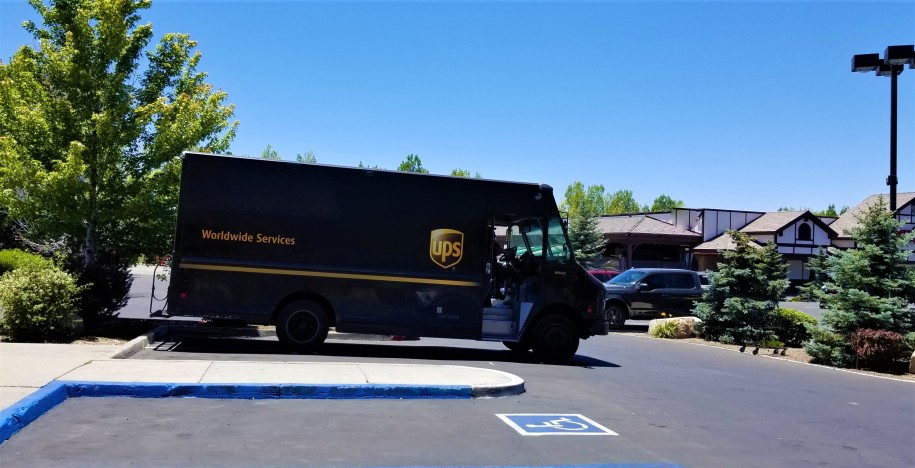Have you ever wondered what the difference is between UPS SurePost VS Ground post? These are both mail services that are offered by UPS, but they aren’t the same service, although they are very similar. SurePost is an attempt by the mail carrier to reduce the cost of the last part of the journey, which is usually the part that bumps up the price. SurePost relies upon the postal network that USPS enjoys to get UPS parcels to the right places as efficiently as possible. This makes it cheaper than Ground shipping, and it does not usually take much longer in spite of the reduced price. It is often only a day slower, and can cost as much as twenty percent less!

What Is SurePost?
SurePost is a service created by UPS to try and reduce the shipping costs for their customers. Often, the most expensive part of shipping an item is getting it to the individual home. The very last leg of the journey, the one where a mail carrier has to walk up to each mailbox and fill it, is the part that drives up the price. This is because all other parts of sending mail can be streamlined. Many parcels can be sorted all at once, and massive distribution centers that use sorting machines and enjoy the cost savings of bulk sorting are very efficient and cost relatively little to run.
As soon as parcels are nearly at their destinations, however, prices go up a lot. For independent couriers like UPS, this is because they may only have one delivery to make in an entire block, and that delivery costs them significantly more than if they have ten deliveries in that block. USPS, however, is delivering to nearly every house on every block every day of the year. By tapping into that network, which is already established and fully operational, SurePost is UPS’s way of making mail delivery cheaper and more efficient.

What Is Ground?
With Ground delivery, UPS drivers take parcels to individual houses and deliver them. As described above, this is not very efficient, because they may only have one address in each area to go to, and so drivers are spending a lot of time driving, and not delivering. Because of this, Ground delivery tends to be more expensive. It is often slightly faster than SurePost because it does not involve passing packages to USPS and making sure that they go into a secondary company’s sorting and distribution system, but it is far more expensive for UPS to run, and at least some of that cost is passed to the customer.
On average, Ground will be about a day quicker than SurePost, but it will cost quite a lot more. While you may not care if you are an individual shipping out packages now and then, the twenty percent difference can make a huge difference if you are a business sending out parcels every day!
How Does SurePost Work?
With the SurePost system, once the package has reached the area it needs to be in, the UPS driver will take it to a local post office, instead of delivering it to an individual house. All parcels for that area will be handed to the post office workers, who will log them as received. Once this is done, the post office will sort them into the piles with normal USPS mail that is being sent by the main postal service, and then the mailman will bring them to the door of each house the following day. This is the part that usually causes the one day delay on SurePost deliveries. With the Ground system, the UPS van would take the mail to the individual houses, rather than to the post office, where it must wait overnight for the mailman.
How Different Is SurePost From Ground?
The only difference between these two systems is how the parcels are handled toward the end of their journey. For most of the parcel’s journey, it will travel in exactly the same manner with either system up until it reaches the last stage, usually the town in which the recipient lives. When it gets to this point, SurePost parcels will be passed to the local post office, while Ground parcels will be distributed via UPS vans to their final destinations. This is all that makes a difference in the two postal systems. Services such as tracking are still available to both customers and shippers.

How Much Does SurePost Cost?
So, if the SurePost system is cheaper, the first question is how much cheaper? Obviously, rates change, but to give you an approximate idea, in the last couple of years, SurePost rates have been as follows:
- Seven pound packages cost between $10.90 and $15.85 (Zones 2 – 8)
- Three pound packages cost between $9.54 and $13.24 (Zones 2 – 8)
- One pound packages cost between $8.52 and $10.63 (Zones 2 – 8)
These are only estimates, but often, SurePost will work out around twenty percent cheaper per parcel you ship, which obviously makes a massive difference to businesses. Steep shipping prices can easily deter customers, so all businesses looking to compete are trying to find ways to reduce the cost of their shipping. Many businesses offer free shipping and swallow the cost themselves, and this is expensive. Being able to reduce that cost, whether it is passed on to the customer or taken by the business, is an enormous benefit that can make a big competitive difference, especially if the business sells low value items in bulk, and so ships lots of packages.
One day added to the estimated shipping is not a big price to pay when it comes to this cost, and a business can – if they choose – offer both the cheap option and the more expensive Ground option, so that customers who are on a tight deadline can still buy from them and get their item in time. This represents the best of both worlds, as most customers will not care if their parcel takes one day longer, but will care about paying higher shipping costs. If the business is sending SurePost items for free, it is possible to calculate the additional shipping charge for Ground and pass only this cost on to the customer, keeping the shipping costs down while ensuring that the business is not losing money for shipping things more quickly.

What Are The Advantages Of SurePost?
So, what are the major advantages of using SurePost? We have discussed the fact that it is cheaper, and this is a great start. However, it’s also important to note that SurePost could actually improve a business’s reach. Because the USPS network is so good, they have access to places that may not be served by UPS. That means that customers who could not previously buy from the business are now able to do so because the shipping has become available. This increases the customer base, which could make a big difference to a business’s turnover.
Just as one example of this, UPS does not deliver to P.O. boxes, but USPS does – meaning a vast swathe of potential customers that the business can market to. Another advantage of SurePost is that USPS delivers on Saturdays, and they offer this service for all mail shipped via the network, including SurePost. UPS will deliver on Saturday, but this usually comes with an additional charge. Because of this, SurePost might actually work out at a similar speed to the UPS’s Ground post, because if you have not paid for Saturday delivery, it won’t move on a Saturday – while SurePost will. Obviously, there is no guarantee that this will have an effect, but it may do, and it is also likely to be attractive to customers who work on weekdays and would rather have items delivered on a Saturday.
How Does SurePost Tracking Work?
You might be wondering how customers (and businesses) can track items sent via SurePost, since these are handled by two separate companies. Fortunately, this is perfectly straightforward, despite the fact that SurePost packages do end up with two shipping labels on them. A single tracking number will be provided, and this allows customers to follow the parcel right through the delivery process, without having to do anything. Unlike FedEx’s joint service, where two tracking numbers are needed to account for the switch-over of carrier, a single one will work for SurePost. This eliminates customer confusion and frustration, and makes everything much easier, reducing the amount of time that businesses need to spend helping customers who haven’t understood the system.

Who Should Use SurePost?
So, who is the SurePost service targeted at? Really, it’s mostly there for the convenience of businesses that need to tap into the network of mail carriers as cheaply and efficiently as possible. You might use SurePost if:
- Your shipments are not urgent
- Your customers care about Saturday delivery being a cheap option
- You ship lots of parcels every week
- Shipping prices are causing you to lose margins or customers or both
- You ship a lot of items to the mainland US, not Hawaii or Alaska
What Are The Disadvantages Of SurePost?
Like any service, SurePost has some negative sides. It is not a great option if you want to ship outside the 48 lower states of the US, for example. It can be done, but you are looking at a prohibitive number of fees and surcharges, and at this point, it is cheaper to use USPS directly than to use SurePost. That might not seem like a big issue to you, but it can be quite annoying for businesses, because it means they have to create exceptions and rules for different customers, and it also irritates customers by complicating the system and charging “unfair” costs dependent on where they live. Overall, that isn’t a great outcome.
A second disadvantage is that one day delay. It may not be a big deal, depending on your industry, but it will put off some customers, especially if you don’t allow them to pick a more expensive, faster postage option. The problem with doing this is that it once again makes your system more complicated, and means workers have to pay more attention to what parcels need to travel via which method. If you are shipping a lot of items per week, it is nicer to be able to make everything simple using one standard mail service.
Thirdly, the unified tracking service can cause some confusion because when the package swaps to USPS, it will show up as “delivered,” but not to the customer’s zip code. This results in customers who need assistance. While the demand should be lower than with FedEx’s dual tracking number system, it is still higher than if you use a single carrier and the tracking information is straightforward.
Another minor con is that you cannot use the free boxes that USPS provides, and you will have to supply your own boxes. UPS does not care what a package is wrapped in, provided it is transportable, but USPS may refuse to handle and deliver a Priority Mail Box that has been misused. This could result in the package being returned to the sender, incurring extra costs. It wastes time and confuses and annoys customers, so it is best avoided. You will have to source your own boxes at an extra cost.
Finally, there are surcharges to be aware of, and these can be quite complex. There is a Non-Machinable Charge for certain packages, and large packages can incur a $14.25 Additional Handling Charge. Again, these add complexity to a business’s shipping system, increasing the manpower needed to handle it.

Summary
UPS SurePost has some major advantages over Ground in terms of price, but you should be aware that it is often a slower shipping option and it can cause customer confusion at times. Think carefully before settling on it for sending or receiving mail. If you find that the UPS system isn’t working for you and you’re always out when they need to deliver a package, consider whether a virtual mailbox could solve your problem and make getting deliveries easier!







